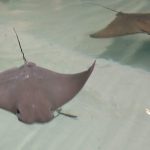by M. Kathy Raines

“Shuffle your feet!” This is tried-and-true advice for those splashing in the surf. But if you forget—if you feel the searing pain of a stingray’s barb—the culprit was likely an Atlantic or a Southern, not a cownose ray (Rhinoptera bonasus).
Southern and Atlantic rays bury themselves in sand, and, since approaching feet sound like a hammerhead scouring for rays, they may deliver a nasty sting. But one’s chance of being injured by the more docile cownose ray—so named for its deeply grooved forehead, resembling a cow’s horns—is remote since it swims in generally shallow but open water. Its barb could, however, pierce an angler who has accidentally snagged it.
An angler releasing a ray, advised Gladys Porter Zoo chief aquarist Dan Goggin, should “flip it over on its back,” thus slowing blood flow to its brain. Rays, like their shark cousins, he noted, become catatonic, and, flipped backwards, their barbed tails “go up over the body,” where they are unlikely to injure anyone. If one approaches a ray from the rear, said Mario Molina, aquarist at the Coastal Studies Laboratory, the ray—mistaking the angler for a shark—may deliver a painful sting.
The cownose ray—called cara de vaca, chucho or manta raya Gavilán in Spanish—gets its genus name, Rhinoptera, from the Greek “rhinos” for nose and “pteron” for wing, as its pectoral, or side, fins resemble wings. Its species name, bonasus, comes from the Greek “bonasos”, meaning bison.
These brown or olive kite-shaped creatures with white bellies, eyes above and seemingly smiling mouths underneath, can reach three feet in width. Their foreheads extend over notched snouts, and their tails hold spines, containing grooves through which toxin and mucous flow, close to their bodies. Rays suck water through spiracles, tiny holes, next to their eyes, exhaling it through gills. The slime coating their bodies, said Molina, reduces drag as they swim, deters parasites, and protects against infection.
Cownose rays, popular in touch tanks, are “less nervous” and “easier to work with” than other rays, noted Goggin. At the zoo, rays delight visitors eager to caress their velvety heads. During weekends, from 1 p.m. to 2 p.m., aquarists show children how to secure a shrimp within their fists so a ray can glide over it, gently seizing the treat.
A cownose ray eats creatures like snails, shrimp, crabs and clams, which it grinds with plate-like teeth, spitting out shells and swallowing soft portions. Having discovered prey— using electroreceptors, smell, and touch—the ray agitates the sand with its wingtips or nose. Then it sucks watery sand into its mouth—the flaps by the mouth forming a useful funnel—blowing it out the gills, to dig a hole that makes prey more accessible.
Cownose rays, which may live up to 21 years, mature late sexually, females maturing at from 7 to 8, males at from 6 to 7 years, and they usually produce only one pup annually. Rays swimming with wingtips above water—sometimes mistaken for sharks— are likely females demonstrating their readiness to mate.
A male, using claspers, or modified fins, grasps the female while depositing sperm. Cownose rays are ovoviviparous; eggs hatch within the mother, where embryos thrive on yolk sacs, then on secretions from her uterus, and 11 to 18-inch long pups are born live, usually in late spring or early summer.
In autumn, cownose rays, common throughout the western Atlantic and the Gulf of Mexico, migrate towards the Yucatan, swimming northwards in spring. Viewers have spotted masses of up to 10,000, some leaping from the water. These rays tend to return to the areas of their birth, as evidenced by the tagging of individual rays.
The International Union for Conservation of Nature (IUCN) lists cownose rays as “near threatened”, a designation lying between of “least concern” and “vulnerable”. Coastal sharks, notably hammerheads and sandbars, prey upon them. Also, cownoses get tangled in shrimp trawls and nets, and anglers sometimes leave them to die or cut them for bait.
Cownose rays were once falsely implicated in wiping out scallops and oysters in Virginia, as expounded upon in a 2007 article in Science, inspiring a campaign called “Save the Bay. Eat a Ray”. Officials encouraged chefs to create tasty recipes for them, and, for PR purposes, the Virginia Marine Resources Commission renamed them Chesapeake Rays. They mistakenly thought that since blacktip and sandbar sharks were in decline, these rays were proliferating uncontrollably, harming the ecosystem.
However, cownose rays never caught on as menu items, and a subsequent article in Scientific Reports rebutted these accusations, finding that blacktip and sandbar sharks ate few rays and a mere 5% of the bellies of cownose rays tested from commercial beds contained oysters. Cownose rays prefer clams and softer-shelled creatures.

